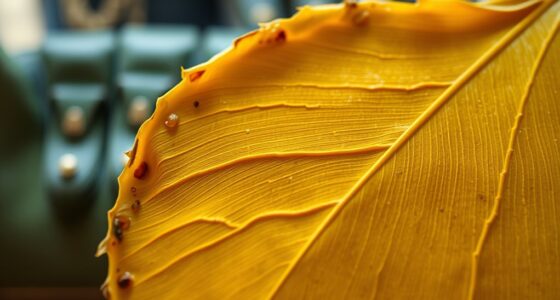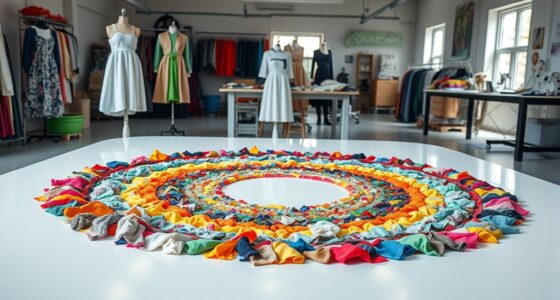Waterless dyeing technology can save up to 8 billion gallons of water annually by eliminating traditional large water baths used in textile manufacturing. It uses innovative methods like supercritical carbon dioxide and foam-based systems, reducing water waste, energy use, and chemical runoff. This approach also cuts costs and lowers environmental impacts, making production more sustainable. If you explore further, you’ll discover how these advancements are transforming industries and promoting eco-friendly practices worldwide.
Key Takeaways
- Waterless dyeing technology eliminates up to 200 gallons of water per pound of fabric, saving billions of gallons annually.
- Innovative methods like supercritical CO2 and foam systems reduce water usage and pollution in textile manufacturing.
- Lower energy consumption from waterless processes decreases greenhouse gas emissions, supporting climate goals.
- Faster, cost-effective production with waterless dyeing benefits manufacturers and reduces environmental impact.
- Industry adoption of waterless dyeing can save approximately 8 billion gallons of water each year.

Waterless dyeing technology is revolutionizing the textile industry by substantially reducing water consumption and environmental impact. As someone interested in sustainable fashion, you’ll appreciate how this innovation can transform manufacturing processes. Traditional dyeing methods rely heavily on large amounts of water, often using up to 200 gallons per pound of fabric, which leads to significant water waste and pollution. Waterless dyeing eliminates the need for water entirely, making your clothing choices more eco-friendly and aligning with the growing demand for sustainable products.
One of the key advantages of waterless dyeing is its use of eco-friendly chemicals. Instead of dyeing fabrics in water baths, specialized dyes are applied directly to fibers using innovative techniques like supercritical carbon dioxide or foam-based systems. These eco friendly chemicals are designed to be less toxic and easier to recycle or dispose of, minimizing harmful runoff and reducing the chemical footprint associated with conventional dyeing. This shift not only benefits the environment but also improves worker safety by decreasing exposure to hazardous substances. By choosing brands that adopt waterless dyeing, you support the use of eco friendly chemicals that are safer for everyone involved in the production process.
Energy efficiency is another critical benefit that makes waterless dyeing a game-changer. Traditional dyeing requires significant heating to facilitate dye absorption in water, consuming large amounts of energy. Waterless systems, however, often operate at lower temperatures or use compressed gases, which drastically cuts energy consumption. This means manufacturers can produce textiles with a smaller carbon footprint, and you can enjoy clothing made with methods that prioritize energy efficiency. When companies adopt waterless dyeing, they not only lower operational costs but also demonstrate a commitment to reducing greenhouse gas emissions, aligning with global efforts to combat climate change. Additionally, increased adoption of innovative techniques fosters industry sustainability, encouraging further eco-conscious advancements in fashion production.
Furthermore, waterless dyeing enhances process efficiency, enabling faster turnaround times and reducing production costs. This efficiency benefits you as a consumer by making sustainable fashion more accessible and affordable. The reduced reliance on water and energy also means less strain on local resources, helping communities preserve their natural water supplies and ecosystems.
Frequently Asked Questions
How Cost-Effective Is Waterless Dyeing Compared to Traditional Methods?
You might find waterless dyeing more cost-effective over time, thanks to significant cost savings on water, energy, and wastewater treatment. Although investment costs can be higher initially, the long-term savings often outweigh these expenses. You’ll benefit from reduced resource use and environmental impact, making waterless dyeing a smart choice for your business. Overall, it’s a financially sound investment with the potential for substantial operational savings.
What Types of Fabrics Are Compatible With Waterless Dyeing Technology?
Imagine the possibilities when choosing fabrics for dyeing—your options are more diverse than you might think. Waterless dyeing technology works best with natural fibers like cotton, wool, and silk, which readily absorb dyes. However, it faces fabric limitations with synthetics like polyester, where dye absorption is more challenging. Knowing these constraints helps you select the right materials to guarantee vibrant, eco-friendly results.
Are There Any Environmental Risks Associated With Waterless Dyeing?
You might wonder if waterless dyeing has environmental risks. While it reduces water use, there’s a chance of chemical runoff if dyes and chemicals aren’t managed properly. This runoff can lead to water contamination, harming ecosystems and human health. To minimize risks, guarantee proper handling, disposal, and regulation of chemicals involved in the process. Overall, with responsible practices, waterless dyeing can be safer than traditional methods.
How Scalable Is Waterless Dyeing for Large Manufacturing Plants?
Scaling waterless dyeing is like turning a small boat into a giant ship—you face scalability challenges, but with the right adjustments, it can navigate large factory waters. You need to contemplate factory integration carefully; existing infrastructure may require upgrades. While initially challenging, advancements in technology are making large-scale adoption more feasible. With dedication, you can transform your manufacturing process to be more sustainable without sacrificing efficiency.
What Are the Regulatory Challenges Facing Waterless Dyeing Adoption?
You’ll need to navigate regulatory compliance, which varies across regions and can slow adoption. Standardization challenges also arise, making it hard to establish consistent industry practices. These hurdles require you to stay updated with evolving policies and advocate for clear standards. Overcoming these regulatory and standardization issues is essential for scaling waterless dyeing technology and realizing its environmental benefits, like saving billions of gallons of water annually.
Conclusion
This waterless dyeing technology is like a gust of fresh air for the planet, transforming the textile industry from a leaky faucet into a sustainable fountain. By saving billions of gallons of water each year, you can be part of this wave of change, turning the tide against waste. Embracing this innovation means you’re not just wearing fashion; you’re helping to nurture a cleaner, greener world—one garment at a time.










